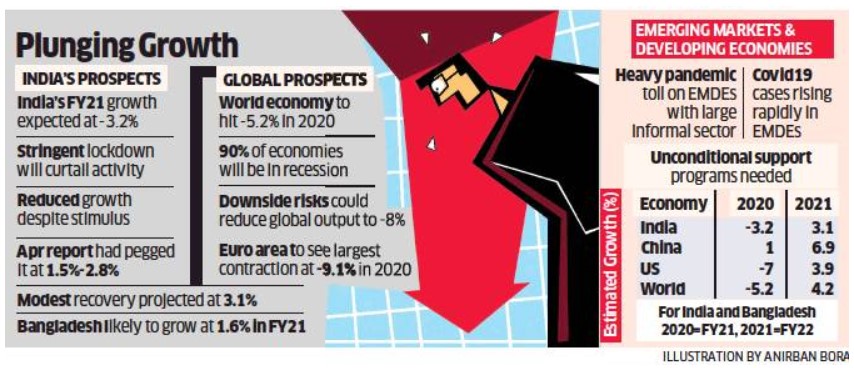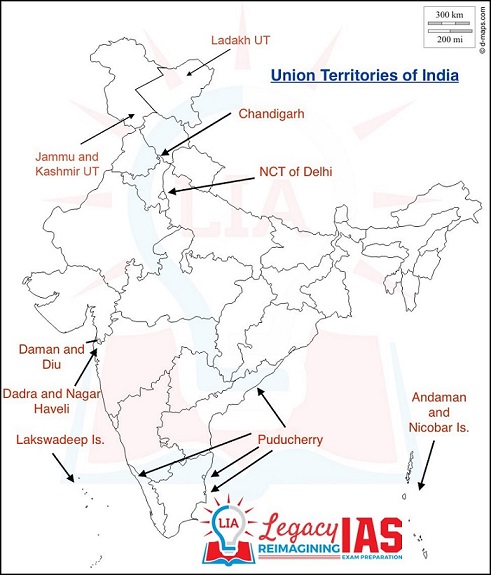Contents
- WB: Indian Economy to contract by 3.2% this fiscal
- L-G overrules Delhi Govt. order to restrict treatment
- Dip in number of self-employed households in FY19
- MSME revival package yet to take off
- Credit risk funds bleed for 14th month in a row
- Military-level talks on India-China standoff positive
WB: INDIAN ECONOMY TO CONTRACT BY 3.2% THIS FISCAL
Focus: GS-III Indian Economy
Why in news?
The Indian economy is expected to contract by 3.2% in this fiscal year, the World Bank said in its Global Economic Prospects (GEP) June 2020 report.
Details
- Indian Economy’s GDP Growth is forecast at 3.1% for 2021.
- The world economy, as a whole, is set to witness its deepest recession since World War II.
- Some 60 million could be pushed into extreme poverty in the world.
- Emerging market and developing economies (EMDEs) are expected to contract by 2.5% in 2020.

Analyzing the numbers
- Countries most reliant on global trade, tourism, external financing and commodity exports are likely to be hit the hardest.
- These forecasts are highly uncertain, and there is a good chance the forecasts will be even worse.
- The high share of workers who are employed in the informal sector exacerbates the health and economic challenges caused by the pandemic.
- Food price increases could also lead to food insecurity for more people and global financial market disruption could add pressure to vulnerable balance sheets.
-Source: The Hindu
L-G OVERRULES DELHI GOVT. ORDER TO RESTRICT TREATMENT
Focus: GS-II Governance
Why in news?
- Lieutenant-Governor in his capacity as Chairperson of the Delhi Disaster Management Authority overruled the Delhi Government’s Decision to restrict COVID-19 treatment.
- The Delhi government had ruled that treatment and admission at both private and government hospitals can be availed only by those bearing documented proof of residence in Delhi.
- In his order on treatment in city hospitals, the L-G made it clear that the Supreme Court had invariably held in several successive judgments that ‘Right to Health’ is an integral part of ‘Right to Life’ under Article 21 of the Constitution.
Lieutenant-Governor
- In the Republic of India, a lieutenant governor is the constitutional head of five of the nine union territories.
- The lieutenant governor is appointed by the President of India for a term of five years, and holds office at the President’s pleasure.
- Since the union territories of Delhi, Jammu and Kashmir and Puducherry have a measure of self-government with an elected legislature and council of ministers, the role of the lieutenant governor there is mostly a ceremonial one, akin to that of a state’s governor.
- In Andaman and Nicobar Islands and Ladakh however, the lieutenant governor holds more power, being both the head of state and head of government.
- The other three union territories—Chandigarh; Dadra and Nagar Haveli and Daman and Diu; and Lakshadweep—are governed by an administrator.
- Unlike the lieutenant governors of other territories, they are usually drawn from the Indian Administrative Service or Indian Police Service.
- Since 1985 the Governor of Punjab has also been the ex-officio Administrator of Chandigarh.
Union Territories
- A Union territory is a type of administrative division in the Republic of India.
- Unlike the states of India, which have their own governments, union territories are federal territories governed directly by the central Government of India.
- The Parliament of India can pass a law to amend the constitution and provide a Legislature with elected Members and a Chief Minister for a union territory, as it has done for Delhi and Puducherry.
- In general, the President of India appoints an administrator or lieutenant governor for each UT.

Extra information of Union Territories
- Delhi, Puducherry and Jammu and Kashmir operate differently from the other six. They were given partial statehood and Delhi was redefined as the National Capital Territory of Delhi (NCT) and incorporated into a larger area known as the National Capital Region (NCR).
- Delhi, Puducherry and Jammu and Kashmir have an elected legislative assembly and an executive council of ministers with partially state-like function.
- In August 2019, the Parliament of India passed Jammu and Kashmir Reorganisation Act, 2019. The act contains provisions to reconstitute the state of Jammu and Kashmir into two union territories, one to be eponymously called Jammu and Kashmir, and the other Ladakh on 31 October 2019.
- In November 2019, the Government of India introduced legislation to merge the union territories of Daman and Diu and Dadra and Nagar Haveli into a single union territory to be known as Dadra and Nagar Haveli and Daman and Diu.
-Source: The Hindu
DIP IN NUMBER OF SELF-EMPLOYED HOUSEHOLDS IN FY19
Focus: GS-III Indian Economy
Why in news?
- The percentage of households that declared themselves self-employed declined both in rural and urban India in FY19.
- The percentage of self-employed households in rural India and urban India dropped by about 0.5% in each.
Analyzing the numbers
- In rural India, the decline is because of a fall in households depending on agriculture, as percentage of those self-employed in non-agricultural activities rose.
- The more than 0.5% reduction (even though it doesn’t seem high) is a very significant reduction for self-employed, particularly in urban India, which suggests that small businesses such as those running small shops have folded up and people running them have become labourers.
- The self-employed people could either be joining the formal workforce, becoming regular wage earners or the casual labour force.
- Formalization is certainly happening, but one would expect a sharper fall in casual workers with greater formalization.
Note: The NSO survey defines self-employed as those who run their own farm or non-farm enterprises or are engaged independently in a profession or trade on own-account or with one or a few partners.
The essential feature of the self-employed is that they have autonomy and economic independence for carrying out their operation.
-Source: Livemint
MSME REVIVAL PACKAGE YET TO TAKE OFF
Focus: GS-III Indian Economy
Why in news?
The Economic Stimulus Package which was to provide ₹20,000 crore equity support to stressed and NPA MSMEs, announced on May 2020 is yet to be operational.
Expectations
The scheme is yet to take off as the Reserve Bank of India (RBI) is yet to issue the guidelines for the scheme.
According to the scheme, the banks were expected to provide subordinate-debt to promoters of stressed MSMEs which would have helped two lakh stressed MSMEs.
Click Here to read more about the Economic Stimulus Package
-Source: The Hindu
CREDIT RISK FUNDS BLEED FOR 14TH MONTH IN A ROW
Focus: GS-III Indian Economy
Why in news?
Credit risk funds saw very high net outflows for the 14th consecutive month.
What is a Credit Risk Fund?
- A credit risk fund is a type of mutual fund that tries to generate higher returns by investing in lower-rated corporate debt.
- Such securities pay out a higher yield than high-rated corporate debt or government bonds which also carry lower risk.
- This category has fared poorly since 2018, when India began experiencing a debt crisis starting with defaults in the IL&FS group.
What are Mutual Funds?
- A mutual fund is a type of financial vehicle made up of a pool of money collected from many investors to invest in securities like stocks, bonds, money market instruments, and other assets.
- Mutual funds are operated by professional money managers, who allocate the fund’s assets and attempt to produce capital gains or income for the fund’s investors.
- A mutual fund’s portfolio is structured and maintained to match the investment objectives stated in its prospectus.
- Mutual funds give small or individual investors access to professionally managed portfolios of equities, bonds, and other securities.
Types of Mutual Funds
The Securities and Exchange Board of India (SEBI) has categorised mutual fund in India under four broad categories:
- Equity Mutual fund scheme: These schemes invest directly in stocks.
- Debt Mutual fund schemes: These schemes invest in debt securities. These schemes are safer than equity schemes and provide modest returns.
- Hybrid Mutual fund Schemes: These schemes invest in a mix of equity and debt, and an investor must pick a scheme based on his risk appetite.
- Solution-Oriented Schemes: These schemes are devised for particular solutions or goals like retirement and child’s education. These schemes have a mandatory lock-in period of five years.
-Source: Times of India
MILITARY-LEVEL TALKS ON INDIA-CHINA STANDOFF POSITIVE
Focus: GS-II International Relations
Why in news?
Talks are on between India and China at the military and diplomatic levels after the recent standoff incidents.
Details
- In June 2020 during the highest military dialogue so far to address the issue, India firmly conveyed that it wants the restoration of status quo ante of April before the stand-off began and China pull back back troops close to the LAC.
- More meetings are scheduled to be held both, military and diplomatic, to end the impasse.
Click Here to read more about the talks and the India-China standoff (1st Article)
-Source: The Hindu





